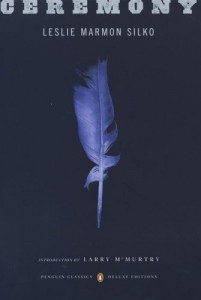Silko, Leslie Marmon (1977). Ceremony. New York: Viking.
Hailed as a masterpiece of Native American literature, this novel has endured over decades and is still a good read. In part that is because the situation of Native Americans has hardly changed in thirty-five years, so the descriptions are still vivid.
The main character is Tayo, a Pueblo Laguna Indian (from the region between Albuquerque and Gallup). He was a Japanese POW in the jungles of Asia during WWII and has returned to the reservation, but he suffers from “shell shock,” a psychiatric disorder somewhere between severe PTSD and schizophrenia. He is mostly bedridden in the first parts of the book, tended by his grandmother and aunt. He is visited by a mysterious medicine man, but it is not clear that does him any good. He eventually recovers and finds love – but he recovers only in the sense that his hallucinations and debilitating weakness leave him; he never does overcome his chronic melancholy and sense of dreamy irrealism.
Conveying that dreamlike view of the world is Silko’s strength as a writer. Tayo’s dreamy psychosis is extremely well-rendered, interwoven with transcriptions of Native mythical tales, such as creation stories. However the conflation of mental disorder and Native myth is confusing. Are we to believe that Native Americans have no concept of mental illness and can’t tell the difference between psychosis and mythology?
Throughout the book, Natives are uniformly portrayed as childlike, unreasoning, superstitious, petulant, profoundly uneducated, uninformed about the world outside the reservation, and claustrophobically obsessed with their own families, traditions, sad fate, and their rage against the whites. Tayo is a despised outsider because he is only half-Indian. This small-mindedness and lack of diversity among characters flattens what little dramatic tension the story has. The characters are stereotypes that do not develop in any dramatic or insightful way. Tayo recovers from his illness and meets a girl. That’s about it.
Nevertheless, the language Silko uses is lofty and lyrical, so much so that the reader can easily enter a woozy dream state while reading, to glimpse another world that modern white people can hardly grasp. I thought young Tayo was going to end up as a medicine man because of his sensitivity and access to the other world, but he doesn’t. He’s just a mixed up kid.
Artistically, Silko uses numerous time cuts to convey the Native American idea of eternal time (so-called “non-linear time”). Silko uses jump-cuts to put Tayo back at the army recruiter’s even after he is home from the war, has his uncle buying the cattle after he already owns them, and so on. Another technique is to flit among places and times in the present. These techniques of fragmentation convey the disjointedness of experience in a culture that has a long history but no future, and which is grasping for a story to understand the present. It’s effective but makes the novel hard to read. The book meanders, with only the slightest thread of storyline.
The insertion of traditional (I assume) Native myths, ceremonies, and songs in seemingly random parts of the story also helps to convey the sense that the other world is ever-present in this one. The book’s main point, apparently, that ceremony (and more generally, story) is all that makes us human, is well-conveyed by that, although it is by no means a convincing thesis. The Native stories and chants are often lyrical, but far too “insider” and alien to a non-Native reader to understand as anything other than pretty poetry.
Some ideas in the novel are disturbing. One is that Indians should not hate the whites because actually, the whites were conjured by evil Indian shamans in the first place for the purpose of making the Indians hate themselves. The idea that your nemesis is your own projection and that victims are more noble than the oppressor (“the meek shall inherit the earth”) is an old and wrong idea. It is troubling to see it here as the guiding idea of the main character.
There are many other problematic ideas presented in the book, such as those around law, land ownership, patriotism, and so on, but perhaps these contradictions and confusions are genuine reflections of Native intellectual life at that time. Overall, the invocation of this particular culture’s world, and worldview, is rich, compelling and rewarding.

